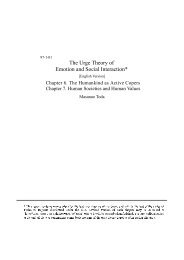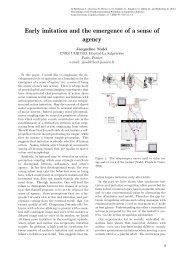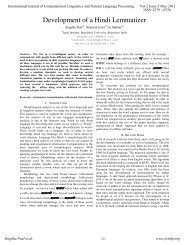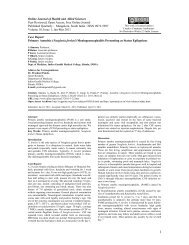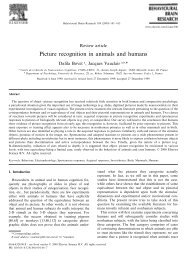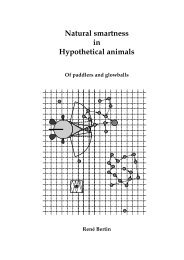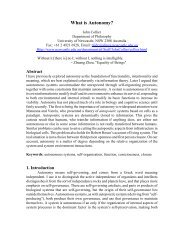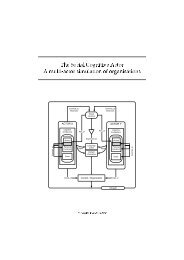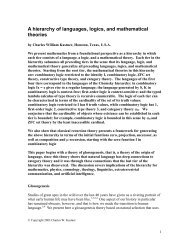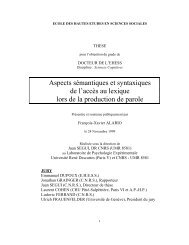A New Computational Schema for Euphonic ... - Cogprints
A New Computational Schema for Euphonic ... - Cogprints
A New Computational Schema for Euphonic ... - Cogprints
Create successful ePaper yourself
Turn your PDF publications into a flip-book with our unique Google optimized e-Paper software.
IJCSI International Journal of Computer Science Issues, Vol. 5, 2009<br />
ISSN (Online): 1694-0784<br />
ISSN (Print): 1694-0814<br />
43<br />
A <strong>New</strong> <strong>Computational</strong> <strong>Schema</strong> <strong>for</strong> <strong>Euphonic</strong> Conjunctions in<br />
Sanskrit Processing<br />
Rama N. 1 and Meenakshi LAKSHMANAN 2<br />
1 Department of Computer Science, Presidency College<br />
Chennai 600 005, India<br />
2 Department of Computer Science, Meenakshi College <strong>for</strong> Women<br />
Chennai 600 024, India<br />
and<br />
Research Scholar, Mother Teresa Women’s University<br />
Kodaikanal 624 101, India<br />
Abstract<br />
Automated language processing is central to the drive to enable<br />
facilitated referencing of increasingly available Sanskrit E-texts.<br />
The first step towards processing Sanskrit text involves the<br />
handling of Sanskrit compound words that are an integral part of<br />
Sanskrit texts. This firstly necessitates the processing of euphonic<br />
conjunctions or sandhi-s, which are points in words or between<br />
words, at which adjacent letters coalesce and trans<strong>for</strong>m.<br />
The ancient Sanskrit grammarian Pāṇini’s codification of the<br />
Sanskrit grammar is the accepted authority in the subject. His<br />
famed sūtra-s or aphorisms, numbering approximately four<br />
thousand, tersely, precisely and comprehensively codify the rules<br />
of the grammar, including all the rules pertaining to sandhi-s.<br />
This work presents a fresh new approach to processing sandhi-s in<br />
terms of a computational schema. This new computational model<br />
is based on Pāṇini’s complex codification of the rules of grammar.<br />
The model has simple beginnings and is yet powerful,<br />
comprehensive and computationally lean.<br />
Keywords: Sanskrit, euphonic conjunction, sandhi, linguistics,<br />
Panini, aphorism, sutra.<br />
1. Introduction<br />
The recognition of Sanskrit as a highly phonetic language<br />
as also one with an extensively codified grammar [1], is<br />
widespread. The very name Saṁskṛt (Sanskrit) means<br />
"language brought to <strong>for</strong>mal perfection". That the Backus-<br />
Naur Form used in the specification of <strong>for</strong>mal languages,<br />
has now come to be popularly known as the Pāṇini-Backus<br />
Form [8, 9], bears ample testimony to this fact.<br />
Sanskrit E-texts are being increasingly made available <strong>for</strong><br />
reference in repositories such as the Göttingen Register of<br />
Electronic Texts in Indian Languages (GRETIL) [11]. Now<br />
the essential first step towards language processing of such<br />
Sanskrit E-texts is to develop efficient algorithms and tools<br />
to handle segmentation in Sanskrit compound words that<br />
are an integral part of Sanskrit texts. This firstly<br />
necessitates the processing of sandhi-s or euphonic<br />
conjunctions.<br />
1.1 Unicode Representation<br />
The Unicode (UTF-8) standard is what has been adopted<br />
universally <strong>for</strong> the purpose of encoding Indian language<br />
texts into digital <strong>for</strong>mat. The Unicode Consortium has<br />
assigned the Unicode hexadecimal range 0900 - 097F <strong>for</strong><br />
Sanskrit characters.<br />
All characters including the diacritical characters used to<br />
represent Sanskrit letters in E-texts are found dispersed<br />
across the Basic Latin (0000-007F), Latin-1 Supplement<br />
(0080-00FF), Latin Extended-A (0100-017F) and Latin<br />
Extended Additional (1E00 – 1EFF) Unicode ranges.<br />
The Latin character set has been employed in this work to<br />
represent Sanskrit letters as E-text. Moreover in this paper,<br />
any Sanskrit text except the names of people is given in<br />
italics. As such, variables such as x, y and z are not<br />
italicized as per the norm.<br />
1.2 The Basis of the Work<br />
Pāṇini, the sage and scholar dated by historians in the<br />
fourth century BC or earlier, codified the rules of the<br />
Sanskrit language based on both the extant vast literature as<br />
well as the language in prevalent use at the time. His<br />
magnum opus, the Aṣṭādhyāyī, which literally means ‘work<br />
in eight chapters’, is regarded by all scholars as the ultimate<br />
authority on Sanskrit grammar. In four parts each, these<br />
eight chapters comprise nearly four thousand sūtra-s or<br />
aphorisms, terse statements in Sanskrit. This grammarcodification<br />
of Pāṇini is perhaps unparalleled, <strong>for</strong> it is terse<br />
and yet comprehensive, complex yet precise. Intensive<br />
study, taking recourse to authoritative commentaries<br />
authored by adroit grammarians, is required to get a grasp<br />
of the work.<br />
Many commentaries on the Aṣṭādhyāyī, such as Sage<br />
Patañjali’s Mahābhāṣya are available and held as authentic
IJCSI International Journal of Computer Science Issues, Vol. 5, 2009 44<br />
and comprehensive. One such authoritative commentary<br />
with a neat, topic-wise classification of Pāṇini’s aphorisms,<br />
is the Siddhānta-kaumudī [2] written in the seventeenth<br />
century by the Sanskrit grammarian, Bhaṭṭoji Dīkṣita. The<br />
most important of these aphorisms were later extracted and<br />
compiled into the Laghu-siddhānta-kaumudī [10] by the<br />
scholar Varadarāja.<br />
It is accepted among Sanskrit scholars that any exploratory<br />
work on Sanskrit grammar must necessarily have the<br />
aphorisms of Pāṇini as its basis, optionally taking recourse<br />
to any of the authoritative commentaries. This work on<br />
euphonic conjunctions is also based directly on Pāṇini’s<br />
aphorisms, and not on secondary or tertiary sources of<br />
in<strong>for</strong>mation. The Siddhānta-kaumudī of Bhaṭṭoji Dīkṣita,<br />
famed and accepted amongst scholars as an unabridged,<br />
comprehensive compendium of the entire Aṣṭādhyāyī, has<br />
been studied in the original Sanskrit, and the euphonic<br />
conjunctions dealt with in it <strong>for</strong>m the basis of this work.<br />
The Laghu-siddhānta-kaumudī was also initially consulted<br />
<strong>for</strong> insights.<br />
1.3 The Māheśvara aphorisms - the backbone of<br />
Pāṇini’s code<br />
The Māheśvara aphorisms, said to have come from the<br />
beats of a special drum called ‘ḍamaru’ (hourglass drum)<br />
held in the hand of Lord Maheśvara (a <strong>for</strong>m of God in the<br />
Hindu pantheon), are a set of aphorisms containing the<br />
letters of the Sanskrit alphabet in a certain sequence. These<br />
aphorisms <strong>for</strong>m the basis of Pāṇini’s composition of his<br />
grammar aphorisms. The Māheśvara aphorisms are<br />
fourteen in number and are listed below:<br />
1. a-i-u-ṇ<br />
2. ṛ-ḷ-k<br />
3. e-o-ṅ<br />
4. ai-au-c<br />
5. ha-ya-va-ra-ṭ<br />
6. la-ṇ<br />
7. ña-ma-ṅa-ṇa-na-m<br />
8. jha-bha-ñ<br />
9. gha-ḍha-dha-ṣ<br />
10. ja-ba-ga-ḍa-da-ś<br />
11. kha-pha-cha-ṭha-tha-ca-ṭa-ta-v<br />
12. ka-pa-y<br />
13. śa-ṣa-sa-r<br />
14. ha-l<br />
The last letter in each of the above aphorisms is only a<br />
place-holder and is not counted as an actual letter of the<br />
aphorism. The first four aphorisms list the short <strong>for</strong>ms of all<br />
the vowels, while the rest list the consonants. It must be<br />
noted that the letter ‘a’ added to each of the consonants is<br />
only to facilitate pronunciation and is not part of the<br />
consonant proper.<br />
2. The Problem<br />
Sandhi-s in Sanskrit are points in words or between words,<br />
at which adjacent letters coalesce and trans<strong>for</strong>m. This is a<br />
common feature of Indian languages and is particularly<br />
elaborately dealt with and used in Sanskrit. The<br />
trans<strong>for</strong>mations that apply are commonly categorized into<br />
four:<br />
1. āgama – addition of an extra letter or set of letters<br />
2. ādeśa – substitution of one or more of the letters<br />
3. lopa – dropping of a letter<br />
4. prakṛtibhāva – no change<br />
(The last is considered a trans<strong>for</strong>mation in the language and<br />
has there<strong>for</strong>e been listed above. However, it may be<br />
ignored <strong>for</strong> practical purposes and is hence not covered in<br />
this work.)<br />
There are close to seventy aphorisms of Pāṇini that deal<br />
with sandhi-s. These aphorisms lay out the rules <strong>for</strong> the<br />
above trans<strong>for</strong>mations, giving the conditions under which<br />
certain letters combine with certain others to give particular<br />
results.<br />
The challenge is to develop a computational algorithm to<br />
handle the entire range of sandhi-s. Such a computational<br />
algorithm would be useful to generate various word <strong>for</strong>ms<br />
of a given Sanskrit word through the application of sandhi<br />
rules. Though this task is not difficult <strong>for</strong> a scholar of<br />
Sanskrit with a thorough knowledge of the Pāṇinian<br />
system, it is certainly a computationally non-trivial task,<br />
given the complexity and number of rules.<br />
Existing methods of sandhi processing, be they methods to<br />
<strong>for</strong>m compound words or even to try to split them, seem to<br />
be based on a derived understanding of the functioning of<br />
euphonic conjunctions, and usually go the finite automata-<br />
HMM-artificial intelligence way [3-7, 12]. However, the<br />
present work directly codifies Pāṇini’s rules as is,<br />
recognizing that Pāṇini’s codification of the grammar is<br />
based on the Māheśvara aphorisms that in turn lay out the<br />
letters of the alphabet in a non-trivial order. This work<br />
presents one novel method of directly representing Pāṇini’s<br />
sandhi rules. It presents, on this basis, a mathematical<br />
<strong>for</strong>mulation of a new approach to solving the non-trivial<br />
problem of handling euphonic conjunctions.<br />
3. The Approach<br />
To take advantage of the ordering of letters of the alphabet<br />
given in 2.3 above, we assign values to each letter in the<br />
Sanskrit alphabet, sticking to the order in the Māheśvara<br />
aphorisms rather than to the commonly adopted ordering of<br />
the letters. Thus, we have the assignment of values <strong>for</strong> the<br />
letters of the alphabet shown in Table 1.<br />
Table 1 : Values <strong>for</strong> the letters of the Sanskrit alphabet<br />
Letter Value Letter Value Letter Value<br />
a 1 l 18 ph 35<br />
ā 2 ñ 19 ch 36<br />
i 3 m 20 ṭh 37<br />
ī 4 ṅ 21 th 38<br />
u 5 ṇ 22 c 39<br />
ū 6 n 23 ṭ 40<br />
ṛ 7 jh 24 t 41<br />
ṝ 8 bh 25 k 42<br />
ḷ 9 gh 26 p 43<br />
e 10 ḍh 27 ś 44<br />
o 11 dh 28 ṣ 45
IJCSI International Journal of Computer Science Issues, Vol. 5, 2009 45<br />
ai 12 j 29 s 46<br />
au 13 b 30 h 47<br />
h 14 g 31 ṁ 48<br />
y 15 ḍ 32 ḥ 49<br />
v 16 d 33 ’ 50<br />
r 17 kh 34 ru 51<br />
Further, the letters are clubbed into various types as given<br />
below:<br />
1. vowels: 1 – 13<br />
2. consonants: 14 – 47<br />
3. semi-vowels: 15 – 18<br />
4. mutes: 19 – 47<br />
5. nasals: 19 – 23<br />
6. non-nasal mutes: 24 - 47<br />
7. soft consonants: 24 – 33<br />
8. hard consonants: 34 - 46<br />
9. column 1: 39 – 43<br />
10. column 2: 34 – 38<br />
11. column 3: 29 – 33<br />
12. column 4: 24 – 28<br />
13. sibilants: 44 – 46<br />
14. aspirate: 14 and 47<br />
15. anusvāra: 48<br />
16. visarga: 49<br />
17. avagraha: 50 (replacement <strong>for</strong> the first vowel)<br />
18. ru: 51 (denotes the letter r but is handled differently)<br />
19. gutturals: 42, 34, 31, 26, 21<br />
20. palatals: 39, 36, 29, 24, 19<br />
21. cerebrals: 40, 37, 32, 27, 22<br />
22. dentals: 41, 38, 33, 28, 23<br />
23. labials: 43, 35, 30, 25, 20<br />
A rule is the name we use <strong>for</strong> letter-level conjunctions such<br />
as the following of the savarṇadīrgha type: a+ā = ā where<br />
the symbol ‘+’ denotes adjacency and the term on the right<br />
of the ‘=’ symbol is the resultant term that has to be either<br />
substituted <strong>for</strong> or added to ones on the left. (In the case of<br />
this particular sandhi, the term on the right is the single<br />
substitute <strong>for</strong> both terms on the left.) Substituting values of<br />
letters from Table 1, this would translate into 1+2 = 2.<br />
Each sandhi may have more than one governing aphorism<br />
that specifies its functioning. Each such aphorism <strong>for</strong> every<br />
sandhi type in turn expands into a series of ‘rules’ as<br />
defined above. In this work, each and every rule <strong>for</strong> each<br />
aphorism under each of the major twenty three sandhi types<br />
were listed. Further, an aphorism would specify if an<br />
addition, deletion or substitution would have to be made. In<br />
accordance with this, a further cataloguing of aphorisms<br />
into five categories was done.<br />
If we denote a sandhi rule as x + y = z where variables x<br />
and y denote the values of single letters joining together to<br />
yield a resultant z, then we have the following<br />
categorizations depending on both the characteristics of z<br />
and on what we actually do with it:<br />
C 1 : replace x and y with single-letter or multi-letter z<br />
C 2 : replace x with single-letter or multi-letter z<br />
C 3 : replace y with single-letter z<br />
C 4 : add single-letter z<br />
C 5 : drop x<br />
Table 2 gives the summary of the numbers involved in this<br />
scenario. It must be noted that in practice, some aphorisms<br />
have to be combined or handled in two different ways to<br />
yield sets of rules, and hence what may seem to be a<br />
discrepancy in the number of aphorisms shown in the table<br />
and the number of rows shown <strong>for</strong> the rules of that<br />
aphorism, is no real discrepancy at all.<br />
As can be seen, there are close to 2500 individual rules<br />
involved, even with considering only the major sandhi-s.<br />
Tabulation of these rules in terms of x, y and z <strong>for</strong> the<br />
categories and then tabulation of the corresponding values<br />
as per Table 1 were done.<br />
Table 2: Summary of the number of Sanskrit sandhi aphorisms and rules<br />
# Sandhi Type<br />
No. of<br />
sūtra-s<br />
Categories<br />
C 1 C 2 C 3 C 4 C 5<br />
Careful observations based on a thorough understanding of<br />
the domain and classification of the input conditions,<br />
yielded the equations presented in this work.<br />
No.<br />
of<br />
Rules<br />
1 yaṇādeśa 1 74 74<br />
50 50<br />
2 ayāyāvāvādeśa 4<br />
2 2<br />
3 3<br />
8 8<br />
3 guṇa 2<br />
18 18<br />
8 8<br />
4 vṛddhi 3 18 18<br />
10 10<br />
5 pararūpa 1 10 10<br />
6 savarṇadīrgha 1 15 15<br />
7 pūrvarūpa 1 2 2<br />
8 avaṅādeśa 1 13 13<br />
13 13<br />
9 tugāgama 4<br />
1 1<br />
23 23<br />
10 jaśtva 2<br />
240 240<br />
5 5<br />
11 satva 2<br />
230 230<br />
138 138<br />
34 34<br />
24 24<br />
12 anusvāra 5<br />
1 1<br />
3 3<br />
13 dhuḍāgama 2 2 2<br />
14 ṅamudāgama 1 195 195<br />
36 36<br />
15 ścutva 2<br />
31 31<br />
31 31<br />
16 ṣṭutva 3<br />
6 6<br />
17 anunāsikā 1 160 160<br />
18 cartva 1 312 312<br />
29 29<br />
19 parasavarṇa 3<br />
5 5<br />
20 pūrvasavarṇa 1 20 20<br />
21 chatva 1 340 340<br />
22 visarga 2<br />
66 66<br />
13 13<br />
23 svādi 5<br />
132 132<br />
33 33<br />
33 33<br />
TOTAL 49 89 1439 397 211 277 2413<br />
13 13<br />
13 13
IJCSI International Journal of Computer Science Issues, Vol. 5, 2009 46<br />
We define the general binary operators<br />
⊕ 1 , ⊕ 2 , ⊕ 3 , ⊕ 4 and ⊕ 5 <strong>for</strong> the categories C 1 , C 2 , C 3 , C 4 and<br />
C 5 respectively, as follows:<br />
C 1 : ⊕ 1 (x, y) = z = z 1<br />
C 2 : ⊕ 2 (x, y) = z = z 2 y<br />
C 3 : ⊕ 3 (x, y) = z = xz 3<br />
C 4 : ⊕ 4 (x, y) = z = xz 4 y<br />
C 5 : ⊕ 5 (x, y) = z = y<br />
where each of z 1 , z 2 , z 3 , z 4 is to be calculated. Now we<br />
introduce the second and third subscripts <strong>for</strong> the above<br />
general operators as follows: the general operator ⊕ i,j (x, y)<br />
is derived from ⊕ i and signifies the operator applying to<br />
aphorism number j of Category C i ; the specialized operator<br />
⊕ i,j,k (x, y) is derived from the operator ⊕ i,j and appertains<br />
to the k th equation <strong>for</strong> the j th aphorism of Category C i ,.<br />
These two extra subscripts are necessitated by the facts that<br />
a category encompasses many aphorisms and one aphorism<br />
may itself be governed by more than one equation.<br />
4. Results and Discussion<br />
The main sandhi aphorisms, their brief description (Rule),<br />
the corresponding general operator and the final,<br />
specialized equations along with the domain of operation<br />
are given below in a category-wise listing. Special<br />
notations followed are:<br />
• The equations and conditions given as operators with<br />
three subscripts are the ones that are implementable.<br />
The ‘general operator’ specified <strong>for</strong> each aphorism<br />
typifies the aphorism’s meaning and all the conditions<br />
it becomes operative under, and provides a<br />
generalization from which the final equations are<br />
specialized. A specialized operator would thus override<br />
the ‘general operator’ with its own specialized<br />
conditions.<br />
• The variable X denotes the sequence of letters<br />
culminating in x; the variable Y denotes the sequence<br />
of letters starting with y. These are used to depict<br />
special conditions that pertain to the entire word<br />
involved in the sandhi.<br />
• Variables u and w represent the value of the letter<br />
occurring just be<strong>for</strong>e x and just after y respectively.<br />
• [ ] are used to club domain conditions simply in order<br />
to depict the ‘or’ condition more clearly.<br />
4.1 C 1 Sandhi-s<br />
guṇa sandhi<br />
1. ādguṇaḥ || 6.1.87 ||<br />
Rule: a or ā followed by i, u (short and long) -> guṇa<br />
letter (e, o) corresponding to second letter replaces<br />
both.<br />
General operator: ⊕ 1,1 (x, y) = z = z 1 when x {1,<br />
2}, y {3, 4, 5, 6}<br />
⊕ 1,1,1 (x, y) : z 1 = 10 when y {3, 4}<br />
⊕ 1,1,2 (x, y) : z 1 = 11 when y {5, 6}<br />
2. uraṇ raparaḥ || 1.1.51 ||<br />
Rule: a or ā followed by ṛ (short and long), ḷ -> guṇa<br />
letter (ar, al) corresponding to the second letter<br />
replaces both.<br />
General operator: ⊕ 1,2 (x, y) = z = z 1 = z 11 z 12 when x<br />
{1, 2}, y {7, 8, 9}<br />
⊕ 1,2,1 (x, y) : z 11 = 1, z 12 = 17 when y {7, 8}<br />
⊕ 1,2,2 (x, y) : z 11 = 1, z 12 = 18 when y {9}<br />
vṛddhi sandhi<br />
3. vṛddhireci || 6.1.88 ||<br />
Rule: a or ā followed by e, o, ai, au -> vṛddhi letter (ai,<br />
au) corresponding to second letter replaces both.<br />
General operator: ⊕ 1,3 (x, y) = z = z 1 when x {1, 2},<br />
y {10, 11, 12, 13}<br />
⊕ 1,3,1 (x, y) : z 1 = y + 2 when y {10, 11}<br />
⊕ 1,3,1 (x, y) : z 1 = y when y {12, 13}<br />
4. etyedhatyūṭhsu || 6.1.89 ||<br />
Rule: In all the following rules, vṛddhi letter (ai, au, ār,<br />
āl) corresponding to the beginning of second word,<br />
replaces both.<br />
a. a or ā followed by the prepositions eti, edhati -> ai<br />
replaces both<br />
b. preposition pra followed by eṣaḥ, eṣya -> ai<br />
replaces both<br />
c. word sva followed by īr -> ai replaces both<br />
d. a or ā followed by the preposition ūh -> au<br />
replaces both<br />
e. word akṣa followed by word ūhini -> au replaces<br />
both<br />
f. preposition pra followed by ūh, ūḍh -> au replaces<br />
both<br />
General operator: ⊕ 1,4 (x, y) = z = z 1 when x {1, 2}<br />
⊕ 1,4,1 (x, y) : z 1 = 12 when [y = 10, Y {10+41+3,<br />
10+28+1+41+3}] or [x = 1, y = 10, X {43+17+1}] or<br />
[x = 1, y = 4, X {46+16+1}, Y {4+17}]<br />
⊕ 1,4,2 (x, y) : z 1 = 13 when [y = 6, Y {6+14}] or [x<br />
= 1, y = 6, X {1+42+45+1}, Y {6+14+3+23+3}]<br />
or [x = 1, y = 6, X {43+17+1}, Y {4+17, 4+27}]<br />
5. etyedhatyūṭhsu || 6.1.89 ||<br />
Rule: In all the following rules, vṛddhi letter (ai, au, ār,<br />
āl) corresponding to the beginning of second word,<br />
replaces both.<br />
a. a followed by word ṛta -> ār replaces both<br />
b. preposition/words pra, vatsara, kambala, vasana,<br />
daśa, ṛṇa followed by the word ṛṇa -> ār<br />
replaces both<br />
General operator: ⊕ 1,5 (x, y) = z = z 1 = z 11 z 12 when x =<br />
1<br />
⊕ 1,5,1 (x, y) : z 11 = 2, z 12 = y + 10 when [y = 7, Y <br />
{7+41+1}] or [X {43+17+1, 16+1+41+46+ 1+17+1,<br />
42+1+20+30+1+18+1, 16+1+46+1+23+ 1,<br />
33+1+44+1, 7+22+1}, Y {7+22+1}]<br />
6. upasargādṛti dhātau || 6.1.91 ||<br />
Rule: a or ā at the end of prepositions followed by ṛ -><br />
vṛddhi letter ār replaces both. (The prepositions that<br />
qualify are: pra, parā, apa, ava, upa)
IJCSI International Journal of Computer Science Issues, Vol. 5, 2009 47<br />
General operator: ⊕ 1,6 (x, y) = z = z 1 = z 11 z 12 when x <br />
{1, 2}, y = 7<br />
⊕ 1,6,1 (x, y) : z 11 = 2, z 12 = y + 10 when X <br />
{43+17+1, 43+1+17+2, 1+43+1,1+16+1, 5+43+1}<br />
pararūpa sandhi<br />
7. eṅi pararūpaṁ || 6.1.94 ||<br />
Rule: a or ā at the end of a preposition followed by e or<br />
o (of a verbal root) -> second letter (e or o) replaces<br />
both.<br />
General operator: ⊕ 1,7 (x, y) = z = z 1 = y when x {1,<br />
2}, y {10,11}<br />
⊕ 1,7,1 (x, y) : z 1 = y when x {1, 2}, y <br />
{10,11}, X {43+17+1, 43+1+17+2, 1+43+1,<br />
1+16+1, 5+43+1}<br />
savarṇadīrgha sandhi<br />
8. akaḥ savarṇe dīrghaḥ || 6.1.101 ||<br />
Rule: a, i, u, ṛ, ḷ (short or long) followed by similar a,<br />
i, u, ṛ, ḷ (short or long) -> corresponding long letter<br />
replaces both.<br />
General operator: ⊕ 1,8 (x, y) = z = z 1 = y when 1
IJCSI International Journal of Computer Science Issues, Vol. 5, 2009 48<br />
General operator: ⊕ 2,8 (x, y) = z = z 2 y = z 21 z 22 y when x<br />
= 20, 34
IJCSI International Journal of Computer Science Issues, Vol. 5, 2009 49<br />
⊕ 2,20,2 (x, y) : z 2 = x when x {29, 30, 31, 32, 33, 44,<br />
45, 46, 47}<br />
⊕ 2,20,3 (x, y) : z 2 = x – 3 when x = 34<br />
⊕ 2,20,4 (x, y) : z 2 = x – 5 when x {35, 37, 38}<br />
⊕ 2,20,5 (x, y) : z 2 = x – 7 when x = 36<br />
⊕ 2,20,6 (x, y) : z 2 = x – 8 when x {40, 41}<br />
⊕ 2,20,7 (x, y) : z 2 = x – 10 when x = 39<br />
⊕ 2,20,8 (x, y) : z 2 = x – 11 when x = 42<br />
⊕ 2,20,9 (x, y) : z 2 = x – 13 when x = 43<br />
cartva sandhi<br />
21. khari ca || 8.4.55 ||<br />
Rule: non-nasal mutes, sibilants, aspirate followed by<br />
hard consonants (column 3, column 4, sibilants) -> first<br />
replaced by its corresponding column 1 or sibilants.<br />
General operator: ⊕ 2,21 (x, y) = z = z 2 y when 24
IJCSI International Journal of Computer Science Issues, Vol. 5, 2009 50<br />
dhuḍāgama sandhi<br />
The aphorisms presented above encompass four out of the<br />
five major sandhi divisions that exist in Sanskrit as per<br />
Pāṇini – vowel, consonant, prakṛtibhāva (no change and<br />
hence not dealt with here), visarga and svādi. The vowel<br />
sandhi-s have been extensively dealt with above, with all<br />
exceptions to main rules incorporated. In the other<br />
divisions, only the main sandhi-s have been covered.<br />
Furthermore, listing of the same aphorism twice was<br />
necessitated by the need <strong>for</strong> different general operators <strong>for</strong><br />
different rules within the same aphorism.<br />
2. ḍaḥ si dhuṭ || 8.3.29 ||<br />
naśca || 8.3.30 ||<br />
Rule: ḍ or n followed by s -> dh added.<br />
General operator: ⊕ 4,2 (x, y) = z = xz 4 y when x {23,<br />
32}, y = 46<br />
⊕ 4,2,1 (x, y) : z 4 = 28<br />
tugāgama sandhi<br />
3. śi tuk || 8.3.31 ||<br />
Rule: n followed by ś -> t added.<br />
General operator: ⊕ 4,3 (x, y) = z = xz 4 y when x = 23, y<br />
= 44<br />
⊕ 4,3,1 (x, y) : z 4 = 41<br />
ṅamuḍāgama sandhi<br />
4. ṅamo hrasvādaci ṅamuṇnityam || 8.3.32 ||<br />
Rule: Short vowel precedes ṅ, ṇ, n which is followed<br />
by vowel -> ṅ, ṇ, n get duplicated.<br />
General operator: ⊕ 4,4 (x, y) = z = xz 4 y when x {21,<br />
22, 23}, 1
IJCSI International Journal of Computer Science Issues, Vol. 5, 2009 51<br />
Sicily, July 2003, in Verification: Theory and<br />
Practice: Essays Dedicated to Zohar Manna on the<br />
Occasion of His 64th Birthday, Ed. Nachum<br />
Dershowitz, Springer-Verlag LNCS vol. 2772, 2004,<br />
pp. 359-372.<br />
[4] Huet Gérard, “Lexicon-directed Segmentation and<br />
Tagging of Sanskrit”, in XIIth World Sanskrit<br />
Conference, Helsinki, Finland, Aug. 2003. Final<br />
version in Themes and Tasks in Old and Middle Indo-<br />
Aryan Linguistics, Eds. Bertil Tikkanen & Heinrich<br />
Hettrich. Motilal Banarsidass, Delhi, 2006, pp. 307-<br />
325.<br />
[5] Huet Gérard, “Shallow Syntax Analysis in Sanskrit<br />
Guided by Semantic Nets Constraints”, Proceedings of<br />
International Workshop on Research Issues in<br />
Digital Libraries, Kolkata, Dec. 2006. Editors<br />
Prasenjit Majumder, Mandar Mitra and Swapan K.<br />
Parui, ACM Digital Library.<br />
[6] Hellwig Oliver, “SanskritTagger, a Stochastic Lexical<br />
and POS Tagger <strong>for</strong> Sanskrit”, Peer-reviewed<br />
Proceedings of the First International Sanskrit<br />
<strong>Computational</strong> Linguistics Symposium, France,<br />
2007.<br />
[7] Hyman Malcolm D., “From Pāninian Sandhi to Finite<br />
State Calculus”, Sanskrit <strong>Computational</strong><br />
Linguistics: First and Second International<br />
Symposia, Revised Selected and Invited Papers,<br />
ISBN:978-3-642-00154-3, Springer-Verlag, 2009.<br />
[8] Rao T. R. N., Kak Subhash, Computing Science in<br />
Ancient India, Center <strong>for</strong> Advanced Computer<br />
Studies, University of Southwestern Louisiana, 1998.<br />
[9] Rao T. R. N., Kak Subhash, The Panini-Backus Form<br />
in Syntax of Formal Languages, Center <strong>for</strong><br />
Advanced Computer Studies, University of<br />
Southwestern Louisiana, 1998.<br />
[10] Varadarāja, Laghu-siddhānta-kaumudī, Translated<br />
with commentary by Panḍit Viśvanātha Śāstri<br />
Prabhākara, Motilal Banarsidas Publishers, Delhi,<br />
1989.<br />
Websites<br />
[11] Göttingen Register of Electronic Texts in Indian<br />
Languages (GRETIL), www.sub.uni-goettingen.de/<br />
ebene_1 /fiindolo/gretil.htm.<br />
[12] Sanskrit Heritage site, Program and<br />
documentation,Gérard Huet, pauillac.inria.fr/~huet/<br />
SKT/.<br />
Department, Department of Computer Science, Meenakshi College<br />
<strong>for</strong> Women, Chennai, India. Is a professional member of the ACM<br />
and IEEE.<br />
Rama N. B.Sc. (Mathematics), Master of Computer Applications,<br />
Ph.D. (Computer Science). Employment: Anna Adarsh College,<br />
Chennai; Bharathi Women’s College, Chennai; Presidency College,<br />
Chennai, India. Has 20 years of teaching experience including 10<br />
years <strong>for</strong> PG, has guided 15 M.Phil. students; Chairperson of the<br />
Board of Studies in Computer Science <strong>for</strong> UG, and Member, Board<br />
of Studies in Computer Science <strong>for</strong> PG and Research at the<br />
University of Madras. Current research interest: Program Security.<br />
Member of Editorial cum Advisory Board of Oriental Journal of<br />
Computer Science and Technology.<br />
Meenakshi Lakshmanan. B.Sc. (Mathematics), Master of<br />
Computer Applications, M.Phil. (Computer Science), currently<br />
pursuing Ph.D. (Computer Science) at Mother Teresa Women’s<br />
University, Kodaikanal, India and pursuing Level 4 Sanskrit<br />
(Samartha) of the Samskṛta Bhāṣā Pracāriṇī Sabhā, Chittoor, India.<br />
Employment: SRA Systems Pvt. Ltd., currently Head of the



